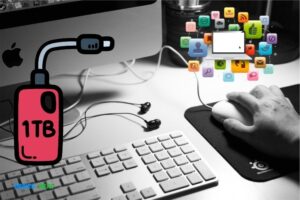How to Set Up External Ssd on Mac: 11 Easy Steps!
To set up an external SSD on your Mac, you need to connect the SSD to your Mac using a USB or Thunderbolt cable, format the SSD using Disk Utility, and then set up Time Machine for backups if desired.
Setting up an external SSD on a Mac involves three major steps.
Firstly, you need to physically connect the SSD to your Mac using a compatible connection method.
Secondly, you need to format the SSD to a Mac-compatible file system using the Mac’s Disk Utility.
Lastly, if you want to use the SSD as a backup drive, you need to set up Time Machine to use the new SSD.
To set up your new external SSD on your Mac, start by connecting it using a USB or Thunderbolt cable.
Once connected, open Disk Utility and select the SSD from the list of drives. Click on Erase and then choose Mac OS Extended (Journaled) as the format.
When the formatting is complete, you can choose to use the SSD as a backup drive by selecting it in Time Machine preferences. The SSD is now ready to use for data storage
11 Steps: Setting Up External SSD on Mac
| Steps | Instructions |
|---|---|
| 1. | Purchase a Compatible SSD |
| 2. | Format the External SSD |
| 3. | Connect SSD to Mac |
| 4. | Open Disk Utility |
| 5. | Select the SSD from the side bar |
| 6. | Click the ‘Erase’ button |
| 7. | In the new window, select ‘Mac OS Extended (Journaled)’ for format |
| 8. | Choose ‘GUID Partition Map’ for Scheme |
| 9. | Click ‘Erase’ to begin formatting |
| 10. | Close Disk Utility after formatting is complete |
| 11. | Copy or move files to the new SSD |
Key Takeaway
Five Facts About: How to Set up External Ssd on Mac
What Is An External Ssd And Why Should You Consider Using One?
External SSDs are a fantastic choice for boosting your Mac’s storage capacity. With easy setup and lightning-fast speeds, these compact devices provide a reliable solution for storing and accessing your data on the go.
Experience faster load times and improved performance by considering an external SSD for your Mac.
External SSDs have become increasingly popular among Mac users who are seeking to improve their device’s performance.
If you’re wondering what exactly an external SSD is and why you should consider using one, you’ve come to the right place.
In this section, we’ll provide an overview of external SSDs and discuss the benefits they offer when connected to your Mac.
Let’s dive in!
An external SSD, or solid-state drive, is a storage device that can be easily connected to your Mac through a USB or Thunderbolt port.
Unlike traditional hard disk drives (HDD), which use mechanical components to store data, SSDs use flash memory chips.
This makes them faster, more reliable, and more durable.
Here’s why you should consider using an external SSD with your Mac:
Benefits Of Using An External Ssd On A Mac:
Faster data transfer speeds:
An external SSD can significantly enhance the speed at which you transfer files to and from your Mac.
With read and write speeds that are generally higher than those of HDDs, tasks such as copying large files or editing high-resolution videos become quicker and more efficient.
Improved overall performance:
By installing applications and running your operating system (OS) from an external SSD, you can experience a noticeable boost in your Mac’s performance.
Applications launch faster, and your Mac operates more smoothly, even when multitasking or running resource-intensive programs.
Enhanced reliability and durability:
Compared to HDDs, external SSDs are less prone to physical damage caused by drops or shocks.
Since they lack mechanical components, they are better equipped to handle the impact of accidental bumps.
Additionally, the absence of moving parts reduces the risk of mechanical failures, making SSDs a more reliable storage solution.
Compact and portable design:
External SSDs are usually smaller, lighter, and more compact than their HDD counterparts.
This makes them highly portable and convenient for users who need to carry their data with them wherever they go.
Whether you’re a student, a creative professional, or a business traveler, an external SSD provides a portable storage option that fits easily into your bag or pocket.
Efficient file organization:
External SSDs offer the benefit of better file organization. You can easily organize your files, folders, and documents on your SSD, allowing for easy navigation and quick access to your data. This improved organization can save you time and increase productivity.
By leveraging the benefits of an external SSD, you can optimize your Mac’s storage, enhance its performance, and enjoy the convenience of portable storage.
Now that you have an understanding of why you should consider using an external SSD, let’s delve deeper into how it can improve your Mac’s performance.
Factors To Consider Before Making A Purchase
Before setting up an external SSD on your Mac, there are several factors to consider.
These include compatibility with your device, storage capacity needed, speed requirements, and the reliability of the brand.
Setting up an external SSD on your Mac can be a game-changer, providing you with additional storage and faster performance.
However, before making a purchase, it’s essential to consider a few factors to ensure you choose the right one for your needs.
Here are some key aspects to think about:
Storage Capacity Requirements:
- Evaluate your storage needs: Determine how much extra storage you require for your Mac. Consider the size of the files you frequently work with, such as videos, photos, or large software applications.
- Future-proof your storage: Anticipate your future storage needs as well, as you wouldn’t want to quickly outgrow your newly added SSD. Opt for a capacity that allows for future expansion.
Speed And Performance:
- Look for fast transfer speeds: One of the main advantages of using an external SSD is its speed. Take note of the SSD’s read and write speeds, as faster speeds will result in quicker file transfers and reduced load times.
- Consider connectivity options: Check if the SSD supports a high-speed interface like USB-C or Thunderbolt. These connections can significantly enhance data transfer rates, ensuring smooth operations and efficient workflows.
Compatibility With Your Mac:
- Check compatible macOS versions: Ensure the external SSD you choose is compatible with your Mac’s operating system. Older models may have limitations, so make sure to verify compatibility.
- Look for plug-and-play functionality: Opt for an SSD that is easy to connect and use with your Mac. Ideally, it should come with the necessary cables or adapters for seamless integration.
- Consider form factor: Depending on your usage preferences, you may wish to choose a slim and portable SSD for on-the-go usage or a desktop-style SSD for a more stationary setup.
Remember, taking the time to evaluate these factors before making a purchase will help you select an external SSD that aligns perfectly with your Mac’s needs.
Checking System Requirements And Compatibility
Before setting up an external SSD on your Mac, it is crucial to check system requirements and compatibility.
Ensuring that your device meets the necessary criteria will guarantee a seamless and efficient setup process.
Ensuring Your Mac Meets The Minimum Requirements
To set up an external SSD on your Mac, it’s crucial to first check if your Mac meets the minimum requirements. This ensures smooth functioning and prevents any compatibility issues.
Here are the essential factors to consider:
Operating System:
Make sure your Mac is running on macOS High Sierra 10.13 or later. You can verify this by clicking on the Apple menu () in the top left corner of your screen, selecting “About This Mac,” and checking the version.
Interface:
Confirm that your Mac has a Thunderbolt 3 (USB-C) or USB 3.2 Gen 2×2 port. This is necessary for a fast and efficient connection.
You can check the port specifications by referring to your Mac’s user manual or visiting the manufacturer’s website.
Storage Space:
Ensure that your Mac has sufficient available storage space to accommodate the data you intend to transfer to the external SSD. Insufficient space may hinder performance and lead to data transfer errors.
RAM:
It’s beneficial to have a decent amount of Random Access Memory (RAM) for optimal performance when working with an external SSD.
Although it’s not a strict requirement, having at least 8GB of RAM is highly recommended.
Power Supply:
Some external SSDs require additional power to function properly. Verify if your Mac provides adequate power supply through the selected port.
If necessary, consider using an external power source or consult the SSD’s manufacturer for guidance.
Verifying If Your Mac Supports External Ssd Connection
Before investing in an external SSD for your Mac, it’s important to ensure that your Mac supports this type of connection.
Here are some methods to verify compatibility:
- Manufacturer’s documentation: Consult the documentation provided by Apple for your specific Mac model. It will outline the supported external storage options and the required connection interfaces.
- Online resources: Visit Apple’s official website or their support page to access detailed information about your Mac model’s compatibility with external SSDs. Look for the technical specifications section or search for “external storage compatibility” using the search bar on the website.
- Consult Apple support: If you’re uncertain about the compatibility of your Mac, reach out to Apple’s customer support for assistance. Provide them with your Mac’s serial number and they will guide you in determining compatibility.
- Third-party tools: Various third-party tools and software can identify the capabilities of your Mac and help determine if it supports external SSDs. Consider using apps like “MacTracker” or “System Information” to gather detailed information about your Mac’s hardware and capabilities.
By ensuring your Mac meets the minimum requirements and verifying compatibility, you can set up your external SSD with confidence and enjoy improved storage capacity and faster data transfer speeds.
Connecting The External Ssd To Your Mac
Learn how to effortlessly connect your external SSD to your Mac and set it up in no time.
Enhance your storage capacity and boost your Mac’s performance with this easy-to-follow guide:
Setting up an external SSD on your Mac can be a game-changer when it comes to maximizing your storage space and boosting performance.
Whether you’re a creative professional working with large files or a casual user looking to speed up your Mac, connecting an external SSD is a straightforward process.
Let’s dive into the steps and make sure you have everything you need to get started.
Using The Appropriate Cable Or Adapter:
To connect your external SSD to your Mac, you’ll need the right cable or adapter.
Here are the options you can choose from, depending on the type of SSD and Mac you have:
- USB-C to USB-C cable: If both your external SSD and Mac have USB-C ports, you can simply connect them using a USB-C to USB-C cable. This provides a fast and reliable connection.
- USB-C to USB-A cable: If your Mac has a USB-A port instead of a USB-C port, you’ll need a USB-C to USB-A cable. This allows you to connect the external SSD to your Mac using the USB-A port.
- Thunderbolt 3 cable: If your external SSD supports Thunderbolt 3 and your Mac has a Thunderbolt 3 port, using a Thunderbolt 3 cable will provide the fastest data transfer speeds.
- Adapter: In some cases, you may need to use an adapter to connect your external SSD to your Mac. For example, if your SSD has a different type of connector than your Mac, you can use a suitable adapter to bridge the gap.
Confirming The Proper Connection:
Once you’ve connected your external SSD to your Mac, it’s important to confirm that the connection is working correctly.
Here’s what you need to do:
- Check Finder: Open Finder on your Mac and look for the external SSD under the “Devices” section. If you see it listed there, it means your Mac has recognized the SSD, and the connection is successful.
- Transfer a file: Copy a small file from your Mac’s internal storage to the external SSD. This will help you ensure that data can be transferred between the two devices without any issues.
- Eject the SSD: When you’re done using the external SSD, make sure to eject it properly before disconnecting it. This will prevent any data corruption and ensure that all files are safely saved.
By following these steps, you can easily set up your external SSD on your Mac and take advantage of its benefits.
Now you’re ready to enjoy the added storage space and improved performance that an external SSD brings to the table.
Happy computing!
Formatting The External Ssd For Mac
Learn how to easily set up an external SSD on your Mac by formatting it correctly. Our step-by-step guide will help you optimize your storage for faster and smoother performance.
To ensure that your external SSD works seamlessly with your Mac, you’ll need to format it using the appropriate settings.
Follow these steps to format your external SSD using Disk Utility and selecting the right file system:
Using Disk Utility To Format The Ssd
To format the external SSD, follow these steps:
- Connect the external SSD to your Mac using the respective USB or Thunderbolt port.
- Open Disk Utility, which you can find by going to Applications > Utilities.
- In Disk Utility, locate your external SSD in the left-hand column. It will be listed as an external drive.
- Select the SSD and click on the Erase button in the toolbar.
- A new window will appear. Here, you can specify the details for formatting the SSD.
Selecting The Appropriate File System
Choosing the right file system is crucial for ensuring compatibility and optimal performance.
Here are the available options, along with their benefits:
- Mac OS Extended (Journaled): This is the default file system for Macs and provides the best compatibility with macOS. It supports large file sizes and offers journaling, which helps protect data integrity.
- APFS (Apple File System): This is the newer file system introduced by Apple and offers improved performance, especially for solid-state drives (SSDs). It supports advanced features like snapshots and space sharing.
- ExFAT: If you need to use the external SSD with both Mac and Windows computers, formatting it as ExFAT is a good option. ExFAT provides cross-platform compatibility and allows for larger file sizes.
Before selecting the file system, consider the intended use of the external SSD. If it is primarily for use with a Mac, Mac OS Extended (Journaled) or APFS would be suitable. If cross-platform compatibility is essential, go for ExFAT.
Once you’ve selected the desired file system, click on the Erase button to format the external SSD with the chosen settings.
Please note that formatting will erase all data on the drive, so make sure to back up any important files before proceeding.
Setting up an external SSD on your Mac involves formatting the drive using Disk Utility and selecting the appropriate file system.
By following these steps, you can ensure that your external SSD is ready for use with your Mac.
Backing Up Your Mac Data
Learn how to effortlessly set up an external SSD on your Mac to safely back up your valuable data.
With simple steps, you can ensure the security of your files while improving your system’s performance. Say goodbye to data loss worries and hello to efficient backups.
Backing up your important files and documents is crucial to ensure the safety and security of your data.
In case of any unforeseen circumstances like hardware failure, system crashes, or accidental deletions, having a backup will give you peace of mind knowing that you can easily restore your files.
In this section, we will discuss the importance of creating a backup and guide you through choosing the right backup method.
Creating A Backup Of Your Important Files And Documents:
Time Machine:
Apple’s built-in backup solution, Time Machine, is a convenient option for Mac users.
By connecting an external SSD to your Mac, you can easily set up a Time Machine backup. Here’s how to do it:
- Connect the external SSD to your Mac using a USB or Thunderbolt port.
- Open “System Preferences” and click on “Time Machine.”
- Click on “Select Disk” and choose your external SSD from the list.
- Click on “Backup Automatically” to enable automatic backups.
- Time Machine will now start creating backups of your important files and documents.
Carbon Copy Cloner:
Another reliable option for backing up your Mac data is Carbon Copy Cloner. This software allows you to create a bootable backup of your entire system, including your macOS and applications.
Follow these steps to set up Carbon Copy Cloner backup:
- Connect the external SSD to your Mac.
- Download and install Carbon Copy Cloner software.
- Launch Carbon Copy Cloner and select your Mac’s startup disk as the source.
- Choose your external SSD as the destination disk.
- Customize your backup options according to your preferences.
- Click on “Clone” to start the backup process.
Online Cloud Storage:
Storing your files in the cloud is becoming increasingly popular due to its convenience and accessibility. Many cloud storage providers offer automatic backup options for Mac users.
Here are some popular choices:
- ICloud Drive: Apple’s cloud storage solution, iCloud Drive, seamlessly integrates with your Mac and allows you to store and sync your files across multiple devices.
- Dropbox: Dropbox offers automatic backup features, file synchronization, and easy file sharing, making it a popular choice among Mac users.
- Google Drive: With generous storage space and easy collaboration features, Google Drive provides a reliable backup solution.
Remember to regularly update your backups to ensure they include your latest files and documents.
Additionally, it’s recommended to keep multiple backups in different locations to provide an extra layer of security for your valuable data.
By following these steps and choosing the right backup method for your needs, you can rest assured that your Mac data is protected and easily recoverable in case of any mishaps.
Transferring Data To The External Ssd
Set up your external SSD on a Mac and transfer your data seamlessly. Follow these easy steps to ensure a smooth and efficient transfer process.
Whether you’re looking to free up space on your Mac or want to have a backup of your important files, transferring data to an external SSD (Solid State Drive) is a smart move. Mac makes it easy to transfer your files with its native applications.
But if you’re looking for more advanced transfer options, third-party software can provide additional features and flexibility.
Using Native Mac Applications (Finder) For File Transfer:
- Open Finder: Launch Finder by clicking on its icon in the dock.
- Connect the external SSD: Plug in your external SSD into the USB port of your Mac.
- Locate the files: In the Finder window, navigate to the files on your Mac that you want to transfer to the external SSD.
- Select the files: Click and drag to select multiple files, or press and hold the Command key while clicking on individual files to select them.
- Copy the files: Once you have selected the files, right-click and choose the “Copy” option, or use the keyboard shortcuts Command + C.
- Navigate to the external SSD: In the Finder window, locate the external SSD under the “Devices” section in the left sidebar.
- Paste the files: Right-click on the external SSD and choose the “Paste” option, or use the keyboard shortcuts Command + V. The selected files will now be transferred to the external SSD.
Using Third-Party Software For More Advanced Transfer Options:
Choose the right software:
There are various third-party software options available that offer advanced features for data transfer, such as syncing files between multiple devices, scheduling backups, and encrypting data for enhanced security.
Research and select:
Take some time to research and select the software that best suits your needs. Popular choices include Carbon Copy Cloner, SuperDuper!, and ChronoSync.
Download and install:
Visit the official website of the chosen software and download the installer. Follow the on-screen instructions to install the software on your Mac.
Connect the external SSD:
After installing the software, connect the external SSD to your Mac using the USB port.
Launch the software:
Open the software you installed and follow its interface to set up the transfer process.
Each software may have a slightly different user interface, but they usually provide clear instructions guiding you through the transfer.
Choose the source and destination:
Specify the source location (Mac) and the destination location (external SSD) for the data transfer, following the instructions provided by the software.
Select the files:
Choose the files you want to transfer from your Mac to the external SSD. Depending on the software, you may be able to transfer selected files/folders or even entire volumes.
Start the transfer:
Once you have made the necessary selections, initiate the transfer process by clicking on the relevant button or following the instructions provided by the software.
The software will handle the rest, transferring the selected files to the external SSD.
Remember, you have the option to use either native Mac applications or third-party software for data transfer to your external SSD. Choose the method that works best for your specific needs and preferences.
Enabling Trim Support
To optimize your external SSD on Mac, it’s crucial to enable TRIM support. This step will ensure proper storage management and improve overall performance for your device.
Follow these steps to set up TRIM support on your Mac and get the most out of your external SSD.
Understanding Trim And Its Benefits
TRIM is a crucial feature that helps optimize the performance and lifespan of your external SSD on a Mac.
By enabling TRIM support, you can ensure that your SSD operates efficiently and maintains its speed over time.
Here’s everything you need to know about TRIM and its benefits:
- TRIM, in simple terms, is a command that allows your Mac’s operating system to communicate with your SSD and effectively manage the data stored on it.
- When files are deleted or modified on an SSD, the TRIM command notifies the drive to erase the underlying data, making it instantly available for new data storage. This process reduces write amplification, maintains ideal performance, and prolongs the SSD’s lifespan.
- TRIM helps prevent performance degradation over time, ensuring consistent read and write speeds even after extended use.
- Enabling TRIM support is especially important for external SSDs that are constantly connected and used for data-intensive tasks like video editing, gaming, or running virtual machines.
- By optimizing data management, TRIM enhances your SSD’s endurance, making it more reliable and efficient in the long run.
Enabling Trim On Your Mac
Now that you understand the importance of TRIM, let’s explore how to enable it on your Mac.
Follow these steps to ensure your external SSD can leverage the benefits of TRIM:
- Check SSD compatibility: Verify that your external SSD is compatible with TRIM. Most modern SSDs support TRIM, but it’s essential to confirm this to avoid any potential issues.
- Open Terminal: To enable TRIM support, you need to access the Terminal application on your Mac. You can find it by navigating to Applications -> Utilities -> Terminal.
- Type the command: In the Terminal window, type the following command:
- Check the response: The Terminal will provide a status message indicating whether TRIM is enabled or disabled on your system. A message stating “TRIM is enabled” confirms that you’ve successfully enabled TRIM support for your external SSD.
By following these steps, you can unlock the full potential of your external SSD and enjoy improved performance and longevity.
Remember to regularly check the status of TRIM support and ensure that it remains enabled for optimal results.
Managing Space And Organization On The External Ssd
In this guide, learn how to effortlessly set up your external SSD on a Mac and effectively manage space and organization.
Discover step-by-step instructions for optimizing your storage and enhancing productivity.
External SSDs are a great way to expand the storage capacity of your Mac and improve the overall performance of your system.
In this section, we will discuss how to effectively manage space and organize your files on an external SSD.
By utilizing Mac’s built-in storage management tools and implementing external SSD-specific organization strategies, you can optimize your storage and enhance productivity.
Utilizing Mac’S Built-In Storage Management Tools:
Optimize Storage:
Mac’s Optimize Storage feature automatically moves infrequently used files to iCloud, freeing up space on your external SSD.
This ensures that you have access to the files you need while minimizing the storage used on your device.
Empty Trash Automatically:
Enabling the Empty Trash Automatically option on your Mac ensures that deleted files are permanently removed from your external SSD, freeing up valuable storage space.
Backup with Time Machine:
Using Mac’s built-in Time Machine feature, you can easily back up your external SSD and ensure that your data is secure. This allows you to restore your files in case of any data loss or system failure.
Implementing External Ssd-Specific Organization Strategies:
Create Folders:
Organizing your files into folders is a fundamental way to keep your external SSD structured and easy to navigate.
Create specific folders for different types of files, such as documents, photos, videos, or projects.
Use Descriptive Filenames:
When saving files to your external SSD, give them clear and descriptive filenames.
This makes it easier to search for specific files and ensures that you can quickly locate what you need.
Utilize Tags and Metadata:
Take advantage of Mac’s tagging and metadata features to further categorize and organize your files on the external SSD.
Assign tags to files based on their content, purpose, or importance, making them easier to find later on.
Regularly Clean Up:
Periodically review and delete unnecessary files from your external SSD to reclaim storage space.
This helps optimize performance and prevents clutter from accumulating over time.
By leveraging Mac’s storage management tools and implementing external SSD-specific organization strategies, you can effectively manage space and keep your files organized on your Mac.
This will not only optimize the performance of your system but also enhance your productivity by making it easier to find and access your important files.
Take the time to organize your external SSD today and enjoy a streamlined storage experience.
Recognizing And Resolving Connection Problems
Looking to set up an external SSD on your Mac? Discover how to recognize and resolve connection problems for a seamless and efficient setup process.
Say goodbye to frustrating issues and enjoy the benefits of increased storage and performance on your Mac device.
External SSDs can be a great addition to your Mac, providing faster data transfer speeds and extra storage capacity.
However, like any technology, connection problems can sometimes arise. In this section, we will explore common connection errors and inconsistencies that you might encounter when setting up an external SSD on your Mac.
We will also discuss how to resolve USB or Thunderbolt-related issues should they occur.
Troubleshooting Connection Errors And Inconsistencies:
- Make sure the external SSD is properly connected to your Mac by checking the cable connections. Ensure that the cables are securely plugged into the USB or Thunderbolt ports on both the Mac and the SSD.
- Restart your Mac and try reconnecting the external SSD. Sometimes, a simple reboot can resolve any connection problems.
- Check if the external SSD is being recognized by your Mac. You can do this by opening Finder and looking for the SSD under the “Devices” section. If the SSD is not listed, it may be a connection issue.
- Verify if the external SSD is compatible with your Mac. Some SSDs may require specific macOS versions or have compatibility limitations. Check the manufacturer’s website or user manual for compatibility information.
- If the external SSD is still not being recognized, try connecting it to a different USB or Thunderbolt port on your Mac. Sometimes, certain ports may have connectivity issues, and switching to a different port can help establish a stable connection.
Resolving Usb Or Thunderbolt-Related Issues:
Update your Mac’s operating system to the latest version. Software updates often include bug fixes and improvements that can address USB or Thunderbolt-related issues.
Reset the SMC (System Management Controller) on your Mac. This can be done by shutting down your Mac, disconnecting the power cord, holding down the power button for 10 seconds, and then reconnecting the power cord and turning on your Mac again. Resetting the SMC can help resolve various hardware-related problems.
Try using a different USB or Thunderbolt cable. A faulty cable can cause connection problems. Swap out the cable if you have a spare one available.
Check for any firmware updates for your external SSD. Manufacturers sometimes release firmware updates to improve compatibility and fix issues. Visit their website and look for any available updates for your specific model.
If possible, test the external SSD on a different Mac or computer. If the SSD works without any problems on another system, it could indicate an issue with your Mac’s hardware or software settings.
Remember that troubleshooting connection problems with an external SSD often involves a process of elimination.
Start with the simple solutions like checking cable connections and restarting your Mac, and then gradually move on to more advanced troubleshooting steps if needed.
By following these steps, you should be able to resolve most connection issues and enjoy the benefits of your external SSD on your Mac.
Addressing Performance Or Compatibility Issues
Looking to address performance or compatibility issues when setting up an external SSD on your Mac? Follow these steps for a seamless and efficient setup process.
Are you experiencing performance or compatibility issues with your external SSD on your Mac?
Don’t worry, we’ve got you covered! By following a few simple steps, you can easily tackle these concerns and get your SSD up and running smoothly.
Let’s delve into the solutions:
Updating Mac’S Operating System And Ssd Firmware:
Updating your Mac’s operating system and SSD firmware can help improve performance and compatibility.
Follow these steps to ensure that everything is up to date:
- Check for Mac updates: Go to the Apple menu and select “System Preferences.” Click on “Software Update” to check for any available updates. Install any pending updates to keep your Mac’s operating system current.
- Check for SSD firmware updates: Visit the manufacturer’s website for your external SSD and look for any firmware updates. Download and install the latest firmware to optimize performance and enhance compatibility with your Mac.
Troubleshooting Performance-Related Concerns:
If you’re still experiencing performance-related concerns with your external SSD, try the following troubleshooting tips:
- Use a compatible cable: Ensure that you’re using a high-quality USB-C or Thunderbolt cable that is compatible with both your Mac and the external SSD. Using a faulty or incompatible cable can lead to performance issues.
- Connect directly to your Mac: Sometimes, connecting your external SSD through a USB hub or other peripherals can cause performance problems. Connect the SSD directly to your Mac’s USB-C or Thunderbolt port to eliminate any potential connection issues.
- Format the SSD to APFS or exFAT: Formatting your external SSD to the Apple File System (APFS) or exFAT can improve performance on Mac. Backup your data before formatting and follow the appropriate steps in Disk Utility to reformat the SSD.
- Check for storage management: Your Mac’s storage management settings may affect the performance of your external SSD. Go to “About This Mac” > “Storage” > “Manage” to optimize storage and clear any unnecessary files that may be impacting performance.
- Reset NVRAM or SMC: Resetting the NVRAM (non-volatile random-access memory) or SMC (system management controller) on your Mac can help resolve performance issues. Follow the instructions provided by Apple to perform a reset on your specific Mac model.
By following these steps, you can address performance or compatibility concerns with your external SSD on your Mac.
Remember to keep your Mac’s operating system and SSD firmware updated, troubleshoot any performance-related issues, and optimize your storage management settings.
Enjoy the enhanced performance and efficiency that an external SSD brings to your Mac experience!
How Do I Connect an External Ssd to My Mac?
Connect the external SSD drive to your Mac using either a USB-C or Thunderbolt cable. Then open Disk Utility, select the SSD from the left pane, and click on Mount to make it available for use.
Do I Need Any Special Software to Set Up an External Ssd on My Mac?
No, you do not need any special software to set up an external SSD on your Mac. You can simply connect the SSD to your Mac using a USB cable and use Disk Utility to format it for use.
What Type of File Systems Does Macos Support for External Drives?
macOS supports the ExFAT, FAT32, and HFS+ file systems for external drives.
Can I Boot from an External Drive?
Yes, you can boot from an External Drive.
Conclusion
Setting up an external SSD on a Mac can greatly enhance your storage capacity, improve performance, and simplify data management.
By following the steps outlined in this guide, you can seamlessly connect your external SSD to your Mac and optimize the storage solution for your specific needs.
From formatting the SSD to selecting the right connection interface, each aspect plays a crucial role in ensuring a smooth experience.
Remember to choose a reliable and fast SSD, consider using encryption for enhanced security, and regularly back up your data to prevent any potential loss.
With your external SSD successfully set up, you can enjoy the benefits of increased storage space, faster data transfer speeds, and improved overall performance on your Mac.
Take advantage of this versatile storage solution and optimize your workflow for increased productivity.






